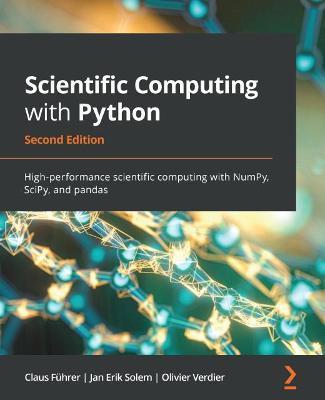Scientific Computing with Python - Second Edition: High-performance scientific computing with NumPy, SciPy, and pandas

Scientific Computing with Python - Second Edition: High-performance scientific computing with NumPy, SciPy, and pandas
Key Features: Learn the first steps within Python to highly specialized concepts Explore examples and code snippets taken from typical programming situations within scientific computing. Delve into essential computer science concepts like iterating, object-oriented programming, testing, and MPI presented in strong connection to applications within scientific computing.
Book Description: Python has tremendous potential within the scientific computing domain. This updated edition of Scientific Computing with Python features new chapters on graphical user interfaces, efficient data processing, and parallel computing to help you perform mathematical and scientific computing efficiently using Python.
This book will help you to explore new Python syntax features and create different models using scientific computing principles. The book presents Python alongside mathematical applications and demonstrates how to apply Python concepts in computing with the help of examples involving Python 3.8. You'll use pandas for basic data analysis to understand the modern needs of scientific computing, and cover data module improvements and built-in features. You'll also explore numerical computation modules such as NumPy and SciPy, which enable fast access to highly efficient numerical algorithms. By learning to use the plotting module Matplotlib, you will be able to represent your computational results in talks and publications. A special chapter is devoted to SymPy, a tool for bridging symbolic and numerical computations.
By the end of this Python book, you'll have gained a solid understanding of task automation and how to implement and test mathematical algorithms within the realm of scientific computing.
What You Will Learn: Understand the building blocks of computational mathematics, linear algebra, and related Python objects Use Matplotlib to create high-quality figures and graphics to draw and visualize results Apply object-oriented programming (OOP) to scientific computing in Python Discover how to use pandas to enter the world of data processing Handle exceptions for writing reliable and usable code Cover manual and automatic aspects of testing for scientific programming Get to grips with parallel computing to increase computation speed
Who this book is for: This book is for students with a mathematical background, university teachers designing mod
PRP: 363.65 Lei
Acesta este Prețul Recomandat de Producător. Prețul de vânzare al produsului este afișat mai jos.
290.92Lei
290.92Lei
363.65 LeiLivrare in 2-4 saptamani
Descrierea produsului
Key Features: Learn the first steps within Python to highly specialized concepts Explore examples and code snippets taken from typical programming situations within scientific computing. Delve into essential computer science concepts like iterating, object-oriented programming, testing, and MPI presented in strong connection to applications within scientific computing.
Book Description: Python has tremendous potential within the scientific computing domain. This updated edition of Scientific Computing with Python features new chapters on graphical user interfaces, efficient data processing, and parallel computing to help you perform mathematical and scientific computing efficiently using Python.
This book will help you to explore new Python syntax features and create different models using scientific computing principles. The book presents Python alongside mathematical applications and demonstrates how to apply Python concepts in computing with the help of examples involving Python 3.8. You'll use pandas for basic data analysis to understand the modern needs of scientific computing, and cover data module improvements and built-in features. You'll also explore numerical computation modules such as NumPy and SciPy, which enable fast access to highly efficient numerical algorithms. By learning to use the plotting module Matplotlib, you will be able to represent your computational results in talks and publications. A special chapter is devoted to SymPy, a tool for bridging symbolic and numerical computations.
By the end of this Python book, you'll have gained a solid understanding of task automation and how to implement and test mathematical algorithms within the realm of scientific computing.
What You Will Learn: Understand the building blocks of computational mathematics, linear algebra, and related Python objects Use Matplotlib to create high-quality figures and graphics to draw and visualize results Apply object-oriented programming (OOP) to scientific computing in Python Discover how to use pandas to enter the world of data processing Handle exceptions for writing reliable and usable code Cover manual and automatic aspects of testing for scientific programming Get to grips with parallel computing to increase computation speed
Who this book is for: This book is for students with a mathematical background, university teachers designing mod
Detaliile produsului










